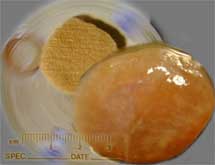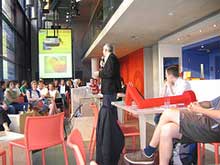We live in an increasingly digital world. Can interactive design inject some humanity into the technology shaping our lives?
Yesterday at the Dana Centre. Usman Haque, architect and artist; Professor Anthony Dunne (beware of that website: will shrink your browser), head of interaction design, Royal College of Art and 6 of his students were discussing Future Worlds: Better by design?


I’ll leave aside Usman Haque’s talk as i felt that his presentation about Pakian Environment in Delft a few months ago was much more inspiring (because he had more time there to present his research on interactivity) and the students’ works will get their own posts.
Tony Dunne’s talk was about interaction design and how it can engage with our future life beyond the design of buttons on the mobile phone. Interaction design is not just about making websites or playing with the interface of communication technologies. The RCA interaction design department looks at how design relates to all sorts of new technologies: nanotechnology, biotechnology, synthetic biology.
First example that Dunne gave is about biotechnology: Oron Catts and Ionat Zurr of the Tissue Culture & Art Project based at the University of Western Australia who grew Semi-Living Food. They grew frog skeletal muscle over biopolymer for food consumption. A biopsy was taken from an animal which continued to live and was displayed in the gallery along side the growing “steak�. The installation culminated in a “feast�.
Can we imagine a future where we would eat the meat grown from a cell of an animal? And from a cell of a person? Would we be ready to eat the resulting steak?
Second example was about synthetic biology that re-designs living organisms: a bacteria with genes from jellyfish designed to flash on and off.
How can designers engage with such kind of technological experiment/progress? How can interaction designers get the debate about possible future in a public context? How can they inspire, raise awareness, stimulate discussion that might eventually lead to a change and prevent any kind of unwanted future to happen? The projects of some of the graduate students make very tangible technologies that seem somewhat abstract or remote from our daily life. They are not real products or services but they bring about scenarios that should trigger all sorts of thinkings in our minds, make us imagine what our daily life could be like when synthetic biology, nao and biotechnology or other emerging technologies will mediate it even more. The department research tries to work as much as possible with other people and bring their preoccupation into a design context.
